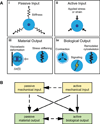To pull or be pulled: parsing the multiple modes of mechanotransduction
- PMID: 23830123
- PMCID: PMC3810169
- DOI: 10.1016/j.ceb.2013.06.002
To pull or be pulled: parsing the multiple modes of mechanotransduction
Abstract
A cell embedded in a multicellular organism will experience a wide range of mechanical stimuli over the course of its life. Fluid flows and neighboring cells actively exert stresses on the cell, while the cell's environment presents a set of passive mechanical properties that constrain its physical behavior. Cells respond to these varied mechanical cues through biological responses that regulate activities such as differentiation, morphogenesis, and proliferation, as well as material responses involving compression, stretching, and relaxation. Here, we break down recent studies of mechanotransduction on the basis of the input mechanical stimuli acting upon the cell and the output response of the cell. This framework provides a useful starting point for identifying overlaps in molecular players and sensing modalities, and it highlights how different timescales involved in biological and material responses to mechanical inputs could serve as a means for filtering important mechanical signals from noise.
Published by Elsevier Ltd.
Figures



References
-
- Wolff J. Das gesetz der transformation der knochen. Berlin: Quarto. 1892
-
- Leckband DE, le Duc Q, Wang N, de Rooij J. Mechanotransduction at cadherin-mediated adhesions. Curr Opin Cell Biol. 2011;23:523–530. - PubMed
-
- Wang Y, Botvinick EL, Zhao Y, Berns MW, Usami S, Tsien RY, Chien S. Visualizing the mechanical activation of Src. Nature. 2005;434:1040–1045. - PubMed
Publication types
MeSH terms
Grants and funding
LinkOut - more resources
Full Text Sources
Other Literature Sources

